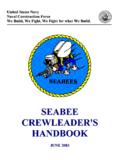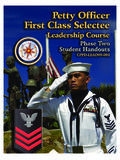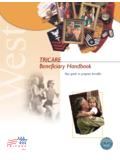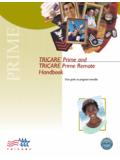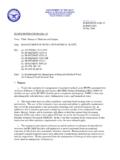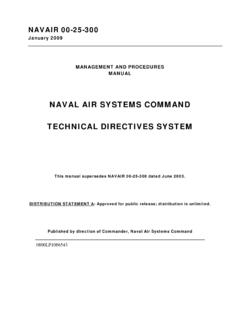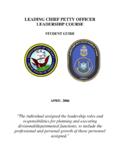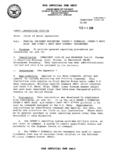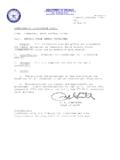Transcription of CHAPTER 6 AIRCRAFT FIREFIGHTING (LPD/ACS)
1 CHAPTER 6 AIRCRAFT FIREFIGHTING (LPD/ACS) Although helicopters are the primary AIRCRAFT operating from amphibious transport docks (LPDs) and air-capable ships (ACS), vertical/short takeoff or landing (V/STOL) AIRCRAFT are also operated at times. Because of the helicopter's ability to land and take off vertically, a crashed helicopter on the flight deck may not cause the entire flight deck to be disabled and, subsequently, stop flight operations until the flight deck is cleared. The ACS flight deck crash, fire, and rescue team functions as a specialized damage control party. ACS is defined as all ships other than carrier; fixed wing AIRCRAFT , nuclear (CVN); amphibious assault ship , general purpose (LHA); and amphibious assault ship, multipurpose (LHD), which have an AIRCRAFT operating capability ( , landing, take-off, vertical replenishment, or hover in-flight refueling (HIFR) operations.)
2 LEARNING OBJECTIVES When you have completed this CHAPTER , you will be able to do the following: 1. Recognize the air department s crash, fire, and rescue organization aboard. 2. Identify the duties and responsibilities of assigned personnel. 3. Identify crash and salvage equipment used aboard ACS. 4. Recognize the capabilities, limitations, and requirements of crash and salvage equipment. 5. Identify AIRCRAFT FIREFIGHTING equipment, operation procedure, and capabilities of FIREFIGHTING equipment use aboard ACS. 6. Recognize standard FIREFIGHTING equipment for ACS. 7. Identify personnel training requirements related to AIRCRAFT FIREFIGHTING and crash personnel. Organization and Operations Air Officer (LPD) On an LPD, the air officer has the overall responsibility for AIRCRAFT FIREFIGHTING , salvage, jettison, and personnel rescue operations occurring on the flight deck and hangar.
3 The air officer is responsible for the direction and coordination of AIRCRAFT movement on the flight deck/landing platform as required during AIRCRAFT crash and fire evolutions. He or she acts on and relays communications from the scene leader to the bridge and damage control central. Helicopter Control Officer (Other Air-Capable Ships) On air-capable ships other than the LPD, AIRCRAFT FIREFIGHTING , salvage, jettison, and personnel rescue operations occurring on the flight deck and hangar duties are normally a function of the helicopter control officer (HCO) or the flight deck officer (FDO). The HCO/FDO, under the supervision of the damage control assistant (DCA) directs all AIRCRAFT FIREFIGHTING and rescue operations on the flight deck and vicinity. AIRCRAFT Crash, Rescue, and Salvage Supervisor (LPD) The AIRCRAFT crash, rescue, and salvage supervisor is responsible for the organization and training of flight deck/landing platform FIREFIGHTING and rescue teams and for AIRCRAFT salvage and jettison operations.
4 He or she is also responsible for the material maintenance readiness and operation of assigned equipment. 6-1 Damage Control Assistant (DCA) In air-capable ships other than the LPD, the DCA, as directed by the engineering officer, is responsible for accomplishing the training required to establish and maintain proficiency in the fundamentals of AIRCRAFT FIREFIGHTING and rescue operations. The DCA shall ensure that each station is fully equipped, that each item of equipment is in working order, and that assigned personnel are familiar with the exact stowage location and proper use of the equipment. Weapons Officer The weapons officer shall keep the air officer/HCO continually updated as to type/quantity of ordnance being used. Manning Crash, Salvage, and Rescue Team The crash team is also the flight deck/landing platform repair team.
5 It serves to fight AIRCRAFT fires on the flight deck, affect the rescue of personnel as required, and perform salvage or jettison procedures as the situation dictates. Team Organization during Flight Operations The following crash, rescue, and salvage team organization is considered minimal for effecting FIREFIGHTING and rescue functions during flight operations. These duties and responsibilities are primary in nature and shall be manned for all evolutions including: Launch Recovery Respot (multi-spot flight decks) Fuel Defuel Maintenance turnups Vertical replenishment (VERTREP) operations HIFR operations For flight operations, a primary flight quarters crash and rescue party shall be manned when an AIRCRAFT is over the deck as follows: LPD Minimum Requirements 1. AIRCRAFT crash, rescue, and salvage supervisor.
6 NOTE DCA shall attend helicopter FIREFIGHTING team training course (#J-495-0414) when assigned to an air-capable ship (to include LPD class ships). NOTE One fully manned hose team shall be used for maintenance turnups without rotors engaged. 6-22. Two aqueous, film-forming foam (AFFF) hose teams. Only one fully manned hose team is required for maintenance turnups when rotors are not engaged. A third hose team shall be manned for weapons cooling (as required). 3. Two rescue persons (hot suitmen). 4. Medical personnel. 5. Two AFFF station/outlet operators (plug men). The third hose team member assigned to each hose may be designated to perform this function. Upon the occurrence of a casualty and activation of the hose, the plug man moves up to handle the hose while minimizing additional personnel exposed to hazards.
7 6. Messengers/phone talkers (as required). The commanding officer (CO) shall determine the mode of communication based on ship s configuration. The requirement for phone talkers may be eliminated if communications can be established and maintained by using other reliable means. 7. AFFF proportioner station operator. Air-Capable Ship Minimum Requirements 1. All declared in-flight emergencies, or at the CO discretion, require the manning described for Condition D below in Table 6-1. An AFFF proportioner station operator is required in accordance with (IAW) CHAPTER 9, page 9-24 with the NATOPS Navy AIRCRAFT FIREFIGHTING and Rescue Manual, NAVAIR 00-80R-14. 2. Reduced manning for unmanned aerial vehicles (UAVs) is based on the hazard posed by current tactical UAVs, such as the Fire Scout or smaller. Deployment of larger UAVs would require reassessment of manning requirements.
8 3. The third hose team member assigned to each hose may be designated to perform the function of AFFF station/outlet operator (plug man). Upon the occurrence of a casualty and activation of the hose, the plug man shall move up to handle the hose while minimizing additional personnel exposed to hazards. This assumes availability of at least two non-collapsible hose reels for flight deck AFFF coverage. Ships without at least two reels available are required to staff to Condition D. 4. For determining messengers/phone talkers requirements, the CO shall determine the mode of communication based on ship s configuration. The requirement for phone talkers may be eliminated if communications can be established and maintained by using other reliable means. 5. For all single AFFF hose team evolutions, the flight deck FIREFIGHTING backup response team must be designated and be able to rapidly respond to any flight deck fire.
9 6. Self-contained breathing apparatus (SCBA) shall be worn by all personnel required to be outfitted in the proximity FIREFIGHTING protective ensemble (PFFPE). 7. External ordnance aviation operations include flight evolutions that require external mounting of ordnance (air-launched guided missiles, torpedoes, rockets) on the AIRCRAFT . It also includes the external transfer (VERTEP) of ordnance onto or off of the flight deck. 8. When two AFFF hose teams are required, personnel from the flight deck crew (chock and chainmen, fuel crew) may be trained and designated to man the second hose team provided all personal protective gear is properly staged for their immediate response. Only one fully manned hose team is required for maintenance turnups when rotors are not engaged. 9. Additional hose teams shall be manned for additional weapons cooling (as required).
10 6-3 10. For corpsman duties and responsibilities, refer to the NATOPS Navy AIRCRAFT FIREFIGHTING and Rescue Manual, NAVAIR 00-80R-14, pages 9- 7. 11. The use of the two rescue personnel as the first hose team along with a third person attired in PFFPE will make a more aggressive first attack capability on a fire than is possible by unprotected personnel. This hose team can quickly cut a rescue path and make an aggressive interior attack if needed. The two rescue personnel can then be relieved of the hose to perform a rescue while the third person in PFFPE remains on the hose. Additional personnel can be used as needed to man the hose. In order to make an immediate attack, all the three hose team members must be fully dressed in PFFPE, including SCBAs, for all takeoffs, landings, VERTREP, and HIFR, if HIFR is performed.

